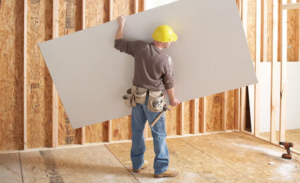The Humvee is a four-wheel drive vehicle with independent suspension on all wheels. Its aluminum body panels are rust-resistant and lightweight. Riveted and bonded, they provide premium strength.
Even as the Army moves toward the newer, lighter JLTV vehicles, it continues investing in new Humvees. These range from a narrower version that fits inside a helicopter to an upgraded variant with a 105mm howitzer. Click the Street Legal Humvee For Sale to learn more.

The Humvee is a military vehicle that can be used for a number of tasks. It can be used to transport cargo and troops, as well as to carry ammunition and weapons. It can even be used to perform reconnaissance missions.
The Army’s name for the Humvee is High Mobility Multipurpose Wheeled Vehicle (HMMWV), but most soldiers call it “Humvee.” The Humvee has become an icon of American ingenuity and adaptability, a symbol of military might. Its influence extends far beyond the battlefield. It has become an enduring cultural icon, and its rugged good looks have captured the imagination of millions of people. Its popularity has even inspired a range of civilian versions, such as the Hummer.
The military Humvee was first deployed in the deserts of the Middle East, where its off-road capabilities and versatility proved essential to operations. Its sturdy design made it the perfect vehicle for transporting equipment, and its stable wheelbase reduced rollover risk. Over the years, the Humvee’s ubiquity grew as the War on Terror unfolded. The military began purchasing thousands of these vehicles in more than a dozen standard configurations. It also began to up-armor some models and replace older ones.
Today, the Humvee is a mainstay of the U.S. military, and it’s likely to remain in service for the foreseeable future. While newer vehicles are emerging, the Humvee is still a versatile and useful vehicle for the Army. It is also a popular choice for many international customers.
HMMWVs are easy to maintain and affordable, with standardized parts and simplified maintenance procedures. They have a high Reliability, Availability, Maintainability (RAM-D) score and meet Army requirements for reliability and survivability. They are also highly maneuverable and can drive off-road with confidence.
In the future, a Humvee might be able to function as an unmanned ground vehicle (UGV). It could use sensors and a camera to navigate terrain, communicate with troops, and deliver cargo without risking human lives. This would allow the US military to expand its presence in the region without relying on helicopters or other expensive platforms.
It’s a tough vehicle
A Humvee is a tough vehicle that can handle many different situations. It is made to withstand rough weather conditions and can drive on unpaved roads for long periods of time. It can also carry a variety of military equipment, including machine guns and tube-launched optically tracked wire command-guided (TOW) anti-tank missiles. It is also very reliable and can go a long way without needing repair or maintenance. However, it can be difficult to drive if you’re not used to it.
The Humvee’s name is derived from its military designation, the High Mobility Multipurpose Wheeled Vehicle. It is a diesel-powered, four-wheel drive vehicle designed to carry a wide variety of military hardware. Its armored shell is capable of protecting its occupants against small arms fire and roadside bombs. In addition, the Humvee can use a pop-up gun turret and ballistic-resistant armor to pursue enemy vehicles.
Unlike a jeep, the Humvee has a large amount of ground clearance. This feature allows it to overcome obstacles such as logs, tree stumps, and rocks. Its high ground clearance also means it can climb and descend steep hills with ease. This is especially important in mountainous areas, where obstacles are common.
In the past, the Humvee was often used in frontline combat in Afghanistan and Iraq. It was a familiar sight whisking soldiers and Marines across vast deserts, but as warfare in those regions became more urban, its aluminum body proved as vulnerable as tissue paper in the face of sniper fire and roadside IEDs. Its reputation as the ultimate “tough guy” vehicle was further solidified by its appearance in popular video games, such as Metal Gear Solid.
Today, the Humvee is being replaced with a newer version called the Joint Light Tactical Vehicle. This new vehicle is more agile than the Humvee and can carry a larger payload. However, it is still very heavy and expensive. Its replacement will likely take longer than expected because of the large scale of the project and changing military priorities.
It’s a reliable vehicle
Humvees are known for being tough and durable, so they can take a beating on the battlefield. They can also be modified to meet specific needs, including armoring. This can protect against small arms fire and shrapnel. In addition, the Humvee’s engine can run underwater, allowing it to move through water and mud.
The vehicle is also easy to drive. While it looks like a tank, it doesn’t require much effort to pilot. It has a three-speed automatic transmission and light steering. It also has a large diesel engine that can go for hundreds of thousands of miles.
If you want to buy a military humvee, it’s important to find a company that specializes in this type of vehicle. Street Legal Exports specializes in military vehicles and can help you find the right vehicle for your needs. They can customize the Humvee to meet your specific needs, and they will make it street legal so you can drive it on the road.
Although the Humvee’s reign as king of military vehicles may be coming to an end, it still has many fans in the civilian world. The vehicle’s off-road capabilities, durability, and iconic status make it a popular choice for people who want to enjoy the outdoors. It’s also a great way to show off your patriotism!
The Army’s newest vehicle, the Joint Light Tactical Vehicle (JLTV), may be better at combating enemy fire, but it’s not as reliable as the Humvee. It also doesn’t have the same off-road capabilities or iconic design that has made the Humvee a symbol of American military power.
While the JLTV is a good vehicle, it will take some time to replace the existing fleet. In the meantime, the Humvee will continue to serve its critical mission roles.
For those looking to purchase a military Humvee, Street Legal Exports is the best place to start. The team has years of experience converting vehicles and can handle all the details for you. Contact them today for more information on buying a military Humvee. They offer a full range of services, from customization to shipping.
It’s a fun vehicle
The Humvee is a fun vehicle, whether you’re a military history enthusiast or just a fan of off-road driving. It’s the kind of vehicle that people dream of driving when they are young, and it’s still a thrill to drive today. You can even find some modern Humvees for sale that are perfect for off-road adventures. But before you buy one, it’s important to know what you’re getting into.
The military Humvee (also known as the HMMWV or Hummer) is a family of light, four-wheel drive military vehicles. Its primary role is to provide military personnel with mobility and firepower in difficult terrain, such as the streets of Mogadishu. The vehicle also offers protection from roadside bombs and machine gun fire.
But despite its popularity, the Humvee has limitations. Its armor is flimsy and it is not equipped to deal with advanced improvised explosive devices (IEDs). The vehicle’s occupants have been killed by these devices in large numbers. In addition, the Humvee’s high center of gravity makes it susceptible to rollover accidents. In addition, its engine has a tendency to overheat.
In 2021, the Army began replacing its fleet of Humvees with a new version called the Joint Light Tactical Vehicle (JLTV). But the JLTV is not better than the Humvee in all ways. For example, it can’t carry as much cargo or as many passengers as the Humvee, and its suspension travel is limited. The JLTV is also heavier than the Humvee, making it more prone to damage.
The JLTV will continue to replace the Humvee on a one-for-one basis through 2050. Some Humvees will remain in service, but only as rear-echelon vehicles for front-line troops. Other Humvees will be retired and sold to civilians for use as recreational vehicles or in museums.
If you want to take your Humvee on a fun adventure, consider adding some key safety upgrades. These upgrades not only make your Humvee safer, but they also help you meet legal requirements and stay safe on the road. Some of these upgrades include GPS navigation systems, which remove blind spots and enhance your awareness of the road.








